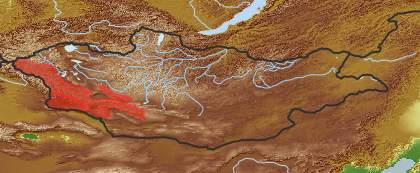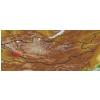| Class: | angiosperms |
| Order: | Ranunculales |
| Family: | Papaveraceae |
| Genus: | Glaucium |
| Scientific name: | Glaucium squamigerum Kar. et Kir. |
| Name acc. to: | Gubanov 1996 |
| Herbar: | list records  |
| Description: | Rigid xerophilous perennial with a basal rosette of runcinate-partite glaucous leaves. Flower pale yellow, 3 - 4 cm diam. Capsule narrowly silicular, 10-15 cm long, densely covered by short curved bristles. |
| Confuse with: | Well-defined species in Mongolia. |
| Link to Flora of China: | http://www.efloras.org/browse.aspx?flora_id=2&name_str=Glaucium+squamigerum |
| open map in a new window |  |
| Habitat: | Gravellous localities in the bottom of canyons within the steppe, forest or subalpine belts of the mountains (Grubov 2001) and in deserts (acc. to Hanelt). |
| Habit (i)general appearance of a plant | |
| Growth form: (i)Herb, shrub, tree or climber. | herb (i)Herbaceous, erect plant, up to 2m high, mostly with a leafy shoot; if perennial, shoots die to the ground each season, shoots are not woody
example: Artemisia pectinata   inherited by family Papaveraceae: herb inherited by family Papaveraceae: herb  inherited by genus Glaucium: herb inherited by genus Glaucium: herb
perennial (i)Living for several to many years, as opposed to annual and biennial  inherited by genus Glaucium: perennial inherited by genus Glaucium: perennial
|
| Smell & Touch: (i)General appearance of the plant. | abundant milky juice (latex) (i)Shoots and often leaves contain white or yellowish latex
example: Asclepiadaceae, Euphorbiaceae, Lactuca tatarica  inherited by family Papaveraceae: abundant milky juice (latex) inherited by family Papaveraceae: abundant milky juice (latex)
|
| Size of plant: (i)Attention: use flowering or fruiting specimens to assess plant height (many biennial plants possess only a basal rosette in the first year). | from 100 mm to 250 mm  inherited by genus Glaucium: inherited by genus Glaucium:
|
| Parasite status: (i)Is the plant a half- or full parasite? | no parasite/saprophyte (i)Plant fully autonomous, leaves with chlorophyll
example: Most plants, Ranunculus  inherited by family Papaveraceae: no parasite/saprophyte inherited by family Papaveraceae: no parasite/saprophyte
|
| Water or terrestrial plant: (i)Where do the plants grow? | terrestrial (i)Plant grows on dry land
example: Orostachys spinosa  inherited by family Papaveraceae: terrestrial inherited by family Papaveraceae: terrestrial
|
| Leaf (i)expanded, usually photosynthetic organ of a plant (including phylloclades) | |
| Leaf development: (i)Structure and development of leaves. | with green leaves (i)Plant with green leaves  inherited by family Papaveraceae: with green leaves inherited by family Papaveraceae: with green leaves
|
| Leaf arrangement: (i)Arrangement of leaves at the stem. | basal rosette (i)Leaves positioned at the base of the stem; stem often without leaves, no visible internodes (but flowers often on erect stems, and these may have few leaves)
example: Limonium, Potentilla, Plantago; also used in Liliales with basaly crouwded leaves (Tofieldia, Zigadenus etc.)   inherited by genus Glaucium: basal rosette inherited by genus Glaucium: basal rosette
|
| Leaf veination: (i)Arrangement of the main veins of a leaf. | pinnate (i)One main vein, several side veins, sometimes inconspicuous
example: Cicerbita     inherited by family Papaveraceae: pinnate inherited by family Papaveraceae: pinnate
|
| Flower (i)reproductive portion of the plant, consisting of sepals, petals, stamens, and pistils | |
| Flower appearance and pollination: (i)General appearance of the flower. | attractive, animal-pollinated (i)attractive and coloured flowers, mostly large, attracting surely animals
example: Trollius, Rosa, Chamaerhodos  inherited by family Papaveraceae: attractive, animal-pollinated inherited by family Papaveraceae: attractive, animal-pollinated
|
| Flower colour: (i)Attention: assess colour of the most colourful parts of the flower, but not of the stamens; be aware of single plants with a mutation (mostly white) on flower colour. | yellow to orange (i)Pale to golden yellow
example: Ranunculus, Crepis  inherited by genus Glaucium: yellow to orange inherited by genus Glaucium: yellow to orange
|
| Perianth arrangement: (i)Attention: in some plants, flowers may be dimorphic in different ways (dioecious or gynodioecious). If flowers vary, record the characters of the most showy flowers. | double, different (i)Two types of perianth leaves, differently coloured (sepals: outer periant leaves, usually greenish, and petals: inner perianth leaves, usually coloured)
example: Parnassia    inherited by family Papaveraceae: double, different inherited by family Papaveraceae: double, different
|
| Diameter of flower: (i)Diameter of flower or flower head. | from 20 mm to 40 mm (i)
example: Aquilegia  inherited by genus Glaucium: inherited by genus Glaucium:
|
| Flower symmetry: (i)Symmetry of the perianth leaves. Attention: to assess this character, look on sepals, petals and stamens, but neglect carpels and ovary. | radiary, regular (actinomorphic) (i)More than two axis of symmetry
example: Saxifraga: 5; Iris: 3   inherited by family Papaveraceae: radiary, regular (actinomorphic) inherited by family Papaveraceae: radiary, regular (actinomorphic)
|
| Flower form: (i)common forms of flowers ? Veronica | simple (flat) - Do not confuse with inflorescences as in some Asteraceae (i)Petals spread out, flower appearing flat
example: Mollugo, Trientalis, Pulsatilla, Saxifraga   inherited by family Papaveraceae: simple (flat) - Do not confuse with inflorescences as in some Asteraceae inherited by family Papaveraceae: simple (flat) - Do not confuse with inflorescences as in some Asteraceae
|
| Sepal number: (i)Number of sepal leaves (outer perianth leaves, calyx leaves, mostly greenish). Attention, this character applies only for flowers separated in sepals and petals, thus excluding most monocots. Be aware of the bracts (involucral leaves) of Asteraceae flowerheads, do not qualify these as sepals! Be also aware in Rosaceae is often an epicalyx developed, in this case count all parts. | 2 (i)
example: Papaveraceae  inherited by family Papaveraceae: 2 inherited by family Papaveraceae: 2
|
| Sepal fusion: (i)To which degree are the sepal leaves connected? Attention, this character applies only for flowers separated in sepals and petals, thus excluding most monocots. Be aware of the bracts (involucral leaves) of Asteraceae flowerheads, do not qualify these as sepals! | free (i)All leaves separate from each other
example: Geranium  inherited by family Papaveraceae: free inherited by family Papaveraceae: free
|
| Petal / Tepal number: (i)Number of petal leaves (inner perianth leaves, usually coloured). | 4 (i)
example: Galium
|
| Petal / Tepal fusion: (i)To which degree are the petal leaves connected? Petals sympetalous. | free (i)all petal leaves separate from each other
example: Anthriscus  inherited by family Papaveraceae: free inherited by family Papaveraceae: free
|
| Spur: (i)A hollow, slender, sac-like appendage of the perianth leaves, storing nectar. | no spur (i)Flower without appendage
example: Peganum  inherited by family Papaveraceae: no spur inherited by family Papaveraceae: no spur
|
| Stamen number: (i)Attention: We ask for the reproductive organs of the flower dispersing pollen. Count only fully fertile stamens, not staminodia (e.g. Parnassia). | > 10 (i)
example: Nymphaea, Callianthemum, Rosa  inherited by family Papaveraceae: > 10 inherited by family Papaveraceae: > 10
|
| Stamen fusion: (i)To which degree are the stamens fused? Attention: Whereas the pollen sacs itself are often free., their stalks (filaments) may be fused. Here, we count them as fused if they are together over at least one thirth of their length. | free (i)Stamens with separate bases
example: Malus  inherited by family Papaveraceae: free inherited by family Papaveraceae: free
|
| Pistil number: (i)Number of pistils (female floral organs: style, if developed; stigma and carpels/ovary together build the pistil). | 1 (i)One carpel, but clearly one stigma
example: Pyrola, Primula, Alyssum  inherited by family Papaveraceae: 1 inherited by family Papaveraceae: 1
|
| Ovary position: (i)For entirely or partly fused carpels, describe their position in relation to the insertion point of perianth leaves (best done by doing a longitudinal section of a flower). | superior (hypogynous) (i)Base of carpels attached above insertion point of perianth leaves, carpels free or fused
example: Delphinium, Anemone    inherited by order Ranunculales: superior (hypogynous) inherited by order Ranunculales: superior (hypogynous)
|
| Sex: (i)Distribution of male and female organs among flowers, only most commonly cases. | bisexual, hermaphrodite (i)All or nearly all flowers of a plant with male and female parts
example: Haplophyllum, Chenopodium  inherited by family Papaveraceae: bisexual, hermaphrodite inherited by family Papaveraceae: bisexual, hermaphrodite
|
| Inflorescence (i)flowering part of a plant, describes the arrangement of the flowers on the flowering axis | |
| Inflorescence: (i)Structure of the inflorescence. | Solitary flowers (i)Each flower grows on an own leafy stem there may be more than one, if the plant has many leafy shoots
example: Viola, Saxifraga hirculus, Rubus arcticus  inherited by genus Glaucium: Solitary flowers inherited by genus Glaucium: Solitary flowers
|
| Fruit (i)the seed bearing organ, with or without adnate parts; a ripened ovary and any other structures which are attached and ripen with it. Aggregate fruits are handled like simple fruits for determination. | |
| Consistency: (i)Fleshy fruits or dry fruits, see dispersal adaptations for further classification. | dry (i)With a dry outer shell, no fleshy parts, but seed (embryo) could be edible  inherited by family Papaveraceae: dry inherited by family Papaveraceae: dry
|
| Type of fruit: (i)Common fruit types (including pseudocarp). | Solitary fruits (i)     inherited by genus Glaucium: Solitary fruits inherited by genus Glaucium: Solitary fruits
Dehiscent fruits (i)Fruits open along a longitudinale line (except silicula)  inherited by genus Glaucium: Dehiscent fruits inherited by genus Glaucium: Dehiscent fruits
silique (i)Dry fruit, opening with two valves and a separating wall inbetween
example: Brassicaceae, Hypecoum    inherited by genus Glaucium: silique inherited by genus Glaucium: silique
|
| Opening of fruit: (i)Mode of dehiscence at maturity to release seeds. | opening along dehiscent line (i)Opening along a preformed line
example: Vicia, Lathyrus: pods  inherited by genus Glaucium: opening along dehiscent line inherited by genus Glaucium: opening along dehiscent line
opening with valves (i)Capsules, siliqua, pods or follicles; opening with two or more dehiscent lines and split off outer parts as valves
example: Alyssum, Arabis: siliqua, Epilobium: four-valved capsule, Arenaria: capsule with three valves.     inherited by genus Glaucium: opening with valves inherited by genus Glaucium: opening with valves
opening / dehiscent (i)Dry? Fruits opening with different types  inherited by family Papaveraceae: opening / dehiscent inherited by family Papaveraceae: opening / dehiscent  inherited by genus Glaucium: opening / dehiscent inherited by genus Glaucium: opening / dehiscent
|
| Size of fruit: (i)Size of the fruit including appendage. | more than 10 mm (i)
example: Malus: wild apple  inherited by genus Glaucium: inherited by genus Glaucium:
|
| Seed number: (i)Estimate the number of seeds per fruit, if recognizable seeds are in the fruit (in rare cases a fruit may contain one seeded nuts: rose hip, carex). | 7-50 (i)Numerable, but may be counted
example: Vaccinum: multi-seeded berry, Ptilotrichum: few-seeded siliqua  inherited by genus Glaucium: 7-50 inherited by genus Glaucium: 7-50
|
| Hairs | |
| Has hairs?: | has hairs  inherited by family Papaveraceae: has hairs inherited by family Papaveraceae: has hairs
|
| Root / shoot below ground (i)plant part below ground (in most cases), including below ground shoots, without leaves | |
| Root type: (i)Organisation of the roots. | allorhizous (i)Plant with a conspicuous tap root, one larger tap root with side roots
example: Dicotyledonae  inherited by order Ranunculales: allorhizous inherited by order Ranunculales: allorhizous
|
| Distribution (i)region where the plant is likely to be found | |
| Distribution (Veg. Zones): (i)acc. to Grubov 1952 | Mongolian Altai (i)In distribution data often named as '7' 
Dzungarian Gobi (i)In distribution data often named as '14' 
acc. to: Gubanov 1996 |